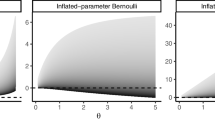Abstract
In this paper, we propose a nonparametric Bayesian model combined with the Indian buffet process (IBP) for a finite impulse response (FIR) system. We develop an FIR system identification method that can simultaneously estimate the number of FIR taps and coefficients. In the proposed model, each FIR tap consists of a coefficient and a gain, and the gain is a binary value. An infinite-dimensional binary vector is composed of binary values, and we assume that this binary vector is generated by the IBP. To identify the FIR system, we specify the likelihood function and prior distributions of the parameters and derive their posterior distributions. We can simultaneously estimate the number of FIR taps and coefficients by sampling from posterior distributions using the Gibbs sampler. Our simulations demonstrate that although the number of FIR taps is unknown, the identification performance of the proposed method in a high signal-to-noise ratio environment is similar to or better than that of the conventional least square solution.








Similar content being viewed by others
References
Goto, M.: A real-time music–scene–description system: predominant-F0 estimation for detecting melody and bass lines in real-world audio signals. Speech Commun. 43(4), 311–329 (2004)
Kameoka, H., Nishimoto, T., Sagayama, S.: A multipitch analyzer based on harmonic temporal structured clustering. IEEE Trans. Audio Speech Lang. Process. 15(3), 982–994 (2007)
Yoshii, K., Goto, M.: A nonparametric Bayesian multipitch analyzer based on Infinite latent harmonic allocation. IEEE Trans. Audio Speech Lang. Process. 20(3), 717–730 (2012)
Rasmussen, C.E.: The infinite Gaussian mixture model. In: Proceedings of 1999 Annual Conference on Neural Information Processing Systems (NIPS), Colorado, November 29–December 4, pp. 554–560 (1999)
Hjort, N.L.: Nonparametric Bayes estimators based on beta processes in models for life history data. Ann. Stat. 18(3), 1259–1294 (1990)
Ghahramani, Z., Griffiths, T.L., Sollich, P.: Bayesian nonparametric latent feature models. In: Proceedings of 2006 8th World Meeting on Bayesian Statistics, North Carolina, June 1–6, pp. 1-19 (2006)
Griffiths, T.L., Ghahramani, Z.: Infinite latent feature models and the Indian buffet process. In: Proceedings of 2005 Annual Conference on Neural Information Processing Systems (NIPS), Vancouver, December 5–8, pp. 475–482 (2005)
Otsuka, T., Ishiguro, K., Sawada, H., Okuno, H.G.: Bayesian nonparametrics for microphone array processing. IEEE Trans. Audio Speech Lang. Process. 22(2), 493–504 (2014)
Kameoka, H., Sato, M., Ono, T., Ono, N., Sagayama, S.: Bayesian nonparametric approach to blind separation of infinitely many sparse sources. IEICE Transactions on Fundamentals, Vol. E96-A, No. 10, October, pp. 1928–1937 (2013)
Yoshii, K., Tomioka, R., Mochihashi, D., Goto, M.: Infinite positive semidefinite tensor factorization for source separation of mixture signals. In: Proceedings of 30th International Conference on Machine Learning (ICML), Atlandta, June 16–21, pp. 576–584 (2013)
Gershman, S.J., Blei, D.M.: A tutorial on Bayesian nonparametric models. J. Math. Psychol. 56(1), 1–12 (2012)
Ferguson, T.S.: A Bayesian analysis of some nonparametric problems. Ann. Stat. 1(2), 209–230 (1973)
Thibaux R., Jordan, M.I.: Hierarchical beta processes and the Indian buffet process. In: Proceedings of 2007 International Conference on Artificial Intelligence and Statistics (AISTATS), Puerto Rico, March 21–24, pp. 564–571 (2007)
Paisley, J., Carin, L.: Nonparametric factor analysis with beta process priors. In: Proceedings of 26th International Conference on Machine Learning (ICML), Montreal, June 14–18, pp. 777–784 (2009)
Zhou, M., Chen, H., Paisley, J., Ren, L., Lin, L., Xing, Z., Dunson, D., Sapiro, G., Carin, L.: Hierarchical beta processes and the Indian buffet process. IEEE Trans. Image Process. 21(1), 130–144 (2012)
Wang, Y., Carin, L.: Levy measure decompositions for the beta and gamma processes. In: Proceedings of 2012 International Conference on Machine Learning (ICML), New York, June 26–July 1, pp. 73–80 (2012)
Teh, Y.W., Jordan, M.I., Beal, M.J., Blei, D.M.: Hierarchical Dirichlet processes. J. Am. Stat. Assoc. 101(476), 1566–1581 (2006)
Gustafsson, F.: Adaptive Filtering and Change Detection. Wiley, New York (2000)
Widrow, B., Hoff, M.E.: Adaptive switching circuits. In: Convention Record IRE Western Electronic Show and Convention (WESCON), August, pp. 96–104 (1960)
Lin, Y., Lee, D.D.: Bayesian \(L_1\)-norm sparse learning. In: Proceedings of 2006 IEEE International Conference on Acoustics, Speech and Signal Processing (ICASSP), Toulouse, May 14–19, pp. 605–608 (2006)
Akaike, H.: A new look at the statistical model identification. IEEE Trans. Autom. Control 19(6), 716–723 (1974)
Liu, J.S.: The collapsed Gibbs sampler in Bayesian computations with applications to a gene regulation problem. J. Am. Stat. Assoc. 89(427), 958–966 (1994)
Author information
Authors and Affiliations
Corresponding author
Appendices
Appendix 1: Probability distributions used in this paper
We describe specification of the probability distributions used in this paper. For a random variable z that can be zero or one, the Bernoulli distribution is defined for \(q\in [0,1]\) as
The beta and gamma distribution of scalar random variable x are
where \(\eta ,b,\beta ,\gamma >0\). The Gaussian distribution of a d-dimensional random variable \(\mathbf {x}\in {\mathbb {R}}^d\) is
Appendix 2: Derivation of the prior distribution of the infinite-dimensional binary vector
The prior distribution \(P_{\mathbf {z}}^\infty (\mathbf {z})\) is derived by integrating \(\alpha \) out from \(P_{\mathbf {z}|\alpha }^\infty (\mathbf {z}|\alpha )\) with \(p_\alpha (\alpha )\), that is,
Since \(p_\alpha (\alpha )\) is conjugate to \(P_{\mathbf {z}}^\infty (\mathbf {z})\), this integral is calculated using the constant term of the gamma distribution as (11).
Appendix 3: Derivation of the evidence
To obtain the evidence \(p_{\mathbf {d}|\mathbf {X},\mathbf {z}}(\mathbf {d}|\mathbf {X},\mathbf {z})\), we integrate \(\mathbf {w}_+\) and s out from (8) as
Equation (20) is obtained by calculating this integral since \(p_{\mathbf {w},s}(\mathbf {w}_+,s)=p_{\mathbf {w}|s}(\mathbf {w}_+|s)p_s(s)\) is conjugate to \(f(\mathbf {d}|\mathbf {X},\mathbf {w},s,\mathbf {z})\).
Rights and permissions
About this article
Cite this article
Tanji, H., Tanaka, R., Murakami, T. et al. FIR system identification based on a nonparametric Bayesian model using the Indian buffet process. SIViP 10, 1105–1112 (2016). https://doi.org/10.1007/s11760-016-0865-x
Received:
Revised:
Accepted:
Published:
Issue Date:
DOI: https://doi.org/10.1007/s11760-016-0865-x




